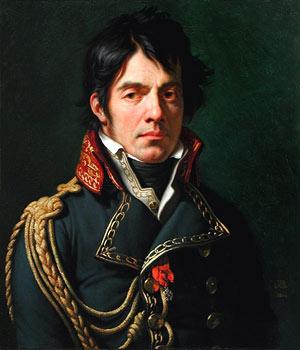Dominique Larrey

Jean-Dominique Larrey (Born 8 July 1766: Died Baudéan - 25 July 1842: Lyon)
Dominique Larrey is a key figure in the history of military medicine. Dubbed the “Providence of Soldiers”, he was a surgeon who performed 800 operations at the Battle of Eylau and is credited with creating mobile ambulances.
Born in Baudéan, near Bagnère-sur-Bigorre, in 1766, into a protestant family from the Pyrenees, Dominique Larrey is the figurehead of Napoleonic battlefields. He studied medicine at the Hôpital Lagrave in Toulouse, under the tutelage of his uncle, Alexis Larrey, a correspondent at the Royal Academy of Surgery. He submitted a thesis on bone decay when he was just twenty-three years old and then left for Paris where his uncle had recommended him to Desault, chief surgeon at the Hôtel-Dieu hospital. He enrolled at the Naval Surgery School in Brest, where he learned the rudiments of early surgery that he was able to apply as chief surgeon on the frigate Vigilante.
In 1791, after passing the highest examinations in his field, he worked at the Hôtel National des Invalides under the protection of Sabatier.
In 1792 he joined the Rhine Army and accompanied it as a doctor on a military campaign in Germany. It was at the Battle of Spire, in September 1792, that he was able to apply the principles of naval surgery. He defied the ban which prohibited medical officers, on land, from being within one league of the battlefield and making them wait for fighting to cease before attending to the injured.
This gave him the idea to improve the poorly organised health service by creating, in Mayence in 1793, an advanced training course for his colleagues. In the Rhine Army, the surgeon Baron François Percy created light ambulances, small chests on wheels used to transport not only nurses but also collapsible and folding stretchers.
Back in Paris, Larrey, his second in command, came up with the idea of "flying ambulances", horse-drawn carriages used to transport the wounded, which would provide a means to evacuate incapacitated soldiers from the battlefield and operate on them within twenty-four hours. Until then, wounded soldiers were left abandoned on the battlefield for several days, laying amongst the dead, until they were eventually gathered up by peasants.
In 1796, Larrey was appointed as professor of surgery at the recently opened military teaching hospital in Val-de-Grâce. An experienced field surgeon, he took part in campaigns for the Revolution, Consulate and Empire. He also founded a school of surgery in Cairo.
Surgeon-in-chief to the Consular Guard (1800), general practitioner for the health service, and surgeon-in-chief in Napoleon’s Grande Armée, Larrey travelled across Europe, visiting Germany, Spain and Austria. At the Battle of Eylau (8 February 1807), he performed some 800 operations in three days. Napoleon I offered him his sword and soon appointed him Commander of the Legion of Honour. He was ennobled as a Baron on the field of Wagram (1809).
His experience in amputation saw him save the lives of nearly three-quarters of the soldiers wounded and avoided the spread of tetanus. He continued to accompany troops on the road and battlefields, which earned him the nickname of the "Providence of Soldiers” during the French Invasion of Russia (1812). Emperor Napoleon, who described Larrey as "the most virtuous man I've ever known", bequeathed him 100,000 francs.
In 1813, in Lutzen-Bautzen, Dominique Larrey is credited for practising the first case of forensic medicine.
Injured and imprisoned in Waterloo, on the verge of being shot, he was saved by a Prussian officer, Blücher, whose son he had already treated.
Liberated, he was concerned about his fate under the Restoration, but eventually received confirmation of his title of Baron in 1815. He was a member of the first year of the Academy of Medicine and made a member of the Institute of Medicine in 1829.
Dominique Larrey died in Lyon after returning from an inspection in Algeria, in 1842, aged 76.

